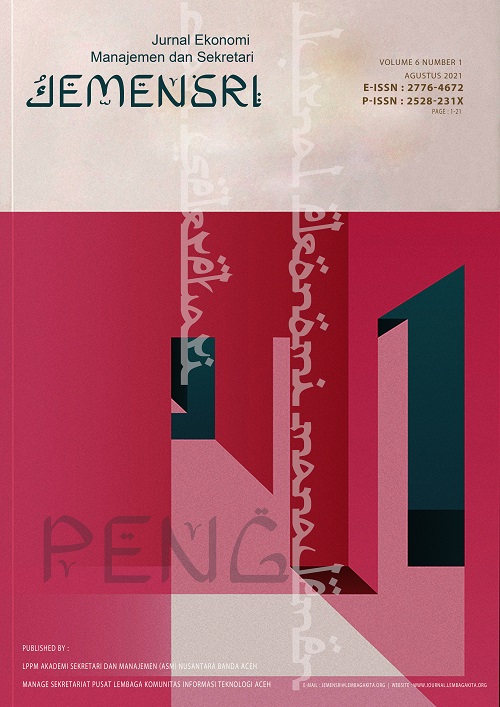Published: 2021-08-31
Average Based Length Fuzzy Time Series Data Seasonal untuk Prediksi Volume Impor Migas Indonesia
DOI: 10.35870/jemensri.v6i1.1764
Adika Setia Brata, Alfian Anhar, Windy Lestari, Melda Juliza, Suci Rahmawati, M Tantry Abeng Evan Nugroho
- Adika Setia Brata: Institut Sains dan Teknologi Nahdlatul Ulama Bali Denpasar , Indonesia
- Alfian Anhar: Institut Sains dan Teknologi Nahdlatul Ulama Bali Denpasar , Indonesia
- Windy Lestari: Institut Sains dan Teknologi Nahdlatul Ulama Bali Denpasar , Indonesia
- Melda Juliza: Institut Sains dan Teknologi Nahdlatul Ulama Bali Denpasar , Indonesia
- Suci Rahmawati: Institut Sains dan Teknologi Nahdlatul Ulama Bali Denpasar , Indonesia
- M Tantry Abeng Evan Nugroho: Institut Sains dan Teknologi Nahdlatul Ulama Bali Denpasar , Indonesia
Article Metrics
- Views 0
- Downloads 0
- Scopus Citations
- Google Scholar
- Crossref Citations
- Semantic Scholar
- DataCite Metrics
-
If the link doesn't work, copy the DOI or article title for manual search (API Maintenance).
Abstract
This study aims to predict the value of Indonesian oil and gas imports using the Fuzzy Time Series method of determining average-based intervals (Average Based Length). The data used in this research is annual periodic data from 2013-2021 which was downloaded from the bps.go.id website. The research results show that the volume value of oil and gas imports in Indonesia in January 2023 will reach 4125,802 thousand tons. This research can be concluded that the accuracy of the estimation is very good, producing a MAPE value of 8.04%. The MAPE value is defined as having very good estimation results if the MAPE value is <10%.
Keywords
FTS (Fuzzy Time Series) ; Data-Based Intervals ; Value of Oil Gas Imports ; MAPE
Article Metadata
Peer Review Process
This article has undergone a double-blind peer review process to ensure quality and impartiality.
Indexing Information
Discover where this journal is indexed at our indexing page to understand its reach and credibility.
Open Science Badges
This journal supports transparency in research and encourages authors to meet criteria for Open Science Badges by sharing data, materials, or preregistered studies.
How to Cite
Article Information
This article has been peer-reviewed and published in the Jurnal Ekonomi Manajemen dan Sekretari. The content is available under the terms of the Creative Commons Attribution 4.0 International License.
-
Issue: Vol. 6 No. 1 (2021)
-
Section: Articles
-
Published: %750 %e, %2021
-
License: CC BY 4.0
-
Copyright: © 2023 Authors
-
DOI: 10.35870/jemensri.v6i1.1764
AI Research Hub
This article is indexed and available through various AI-powered research tools and citation platforms. Our AI Research Hub ensures that scholarly work is discoverable, accessible, and easily integrated into the global research ecosystem. By leveraging artificial intelligence for indexing, recommendation, and citation analysis, we enhance the visibility and impact of published research.




Adika Setia Brata
Program Studi Statistik, Institut Sains dan Teknologi Nahdlatul Ulama Bali Denpasar, Kota Denpasar, Provinsi Bali, Indonesia
Alfian Anhar
Program Studi Statistik, Institut Sains dan Teknologi Nahdlatul Ulama Bali Denpasar, Kota Denpasar, Provinsi Bali, Indonesia
Windy Lestari
Program Studi Statistik, Institut Sains dan Teknologi Nahdlatul Ulama Bali Denpasar, Kota Denpasar, Provinsi Bali, Indonesia
Melda Juliza
Program Studi Statistik, Institut Sains dan Teknologi Nahdlatul Ulama Bali Denpasar, Kota Denpasar, Provinsi Bali, Indonesia
Suci Rahmawati
Program Studi Sistem Informasi, Institut Sains dan Teknologi Nahdlatul Ulama Bali Denpasar, Kota Denpasar, Provinsi Bali, Indonesia

This work is licensed under a Creative Commons Attribution-NonCommercial-NoDerivatives 4.0 International License.
Authors who publish with this journal agree to the following terms:
1. Copyright Retention and Open Access License
Authors retain copyright of their work and grant the journal non-exclusive right of first publication under the Creative Commons Attribution 4.0 International License (CC BY 4.0).
This license allows unrestricted use, distribution, and reproduction in any medium, provided the original work is properly cited.
2. Rights Granted Under CC BY 4.0
Under this license, readers are free to:
- Share — copy and redistribute the material in any medium or format
- Adapt — remix, transform, and build upon the material for any purpose, including commercial use
- No additional restrictions — the licensor cannot revoke these freedoms as long as license terms are followed
3. Attribution Requirements
All uses must include:
- Proper citation of the original work
- Link to the Creative Commons license
- Indication if changes were made to the original work
- No suggestion that the licensor endorses the user or their use
4. Additional Distribution Rights
Authors may:
- Deposit the published version in institutional repositories
- Share through academic social networks
- Include in books, monographs, or other publications
- Post on personal or institutional websites
Requirement: All additional distributions must maintain the CC BY 4.0 license and proper attribution.
5. Self-Archiving and Pre-Print Sharing
Authors are encouraged to:
- Share pre-prints and post-prints online
- Deposit in subject-specific repositories (e.g., arXiv, bioRxiv)
- Engage in scholarly communication throughout the publication process
6. Open Access Commitment
This journal provides immediate open access to all content, supporting the global exchange of knowledge without financial, legal, or technical barriers.
